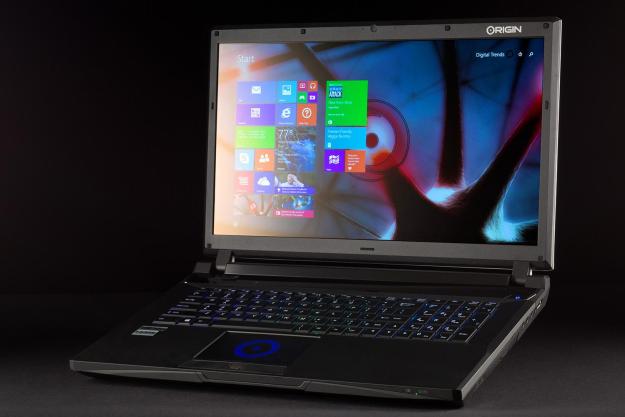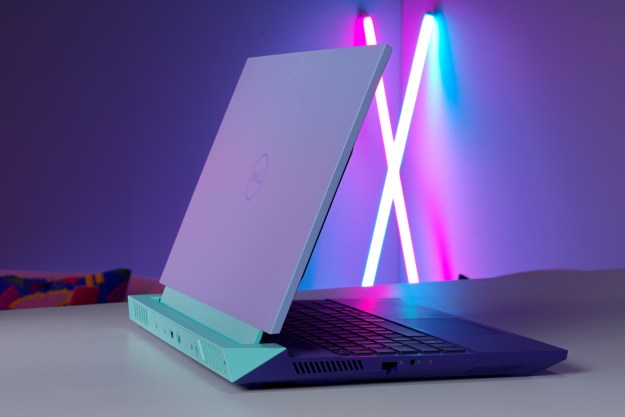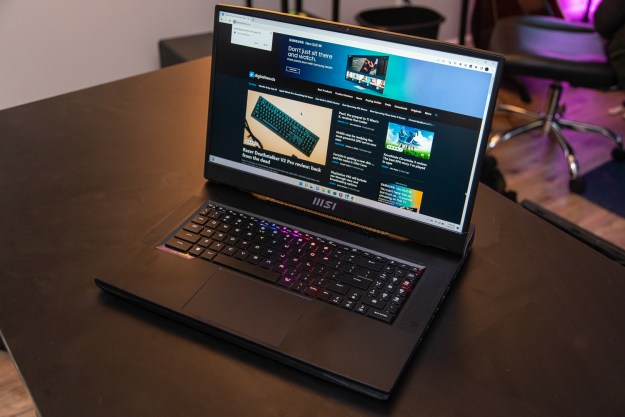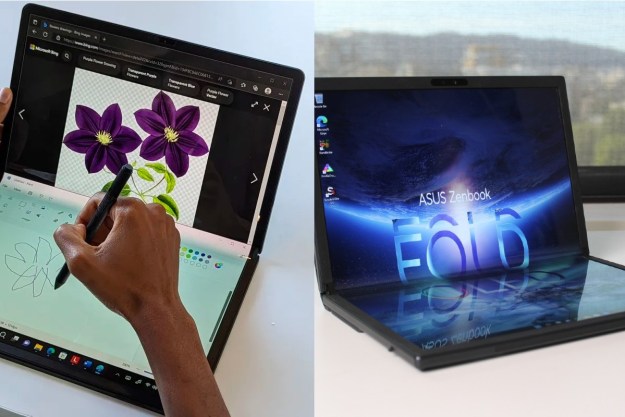
“The Origin EON17-S assembles a hardware dream-team, but the excitement is spoiled by a lackluster 1080p display with wildly inaccurate color.”
- Attractive and well-built
- Lots of connectivity
- Large keyboard and touchpad
- Extreme performance in all areas
- Display suffers from extremely inaccurate color
- Thick and heavy
- Poor battery life
Laptops have become extremely portable over the last few years, shedding pounds like a victorious Biggest Loser contestant. This has mostly been for the best, but some gamers might disagree, as small systems like the Razer Blade are often short on raw power.
Origin, a company that’s never one to follow popular trends blindly, has taken a different path with its EON17-S. Massive, thick and heavy, this customizable laptop packs an Intel Core i7-4930MX, an Nvidia GTX 880M GPU, 16GB of RAM and not one, or two, but three hard drives, two of which are solid state. This is a laptop that can send many desktops running in fear.
Powerful hardware doesn’t come cheap, however. While the base model EON17-S rings up at a modest $1,549, our high-end variant adds almost two grand to that, for a total of $3,492. Does this extravagant laptop makes sense for hardcore gamers?
Video review
Large and in charge
Our review unit wears a white display lid that contrasts sharply with the matte black interior and lower chassis. While a Stormtrooper comparison seems obvious, the laptop’s sharp lines have more in common with a muscle car than one of Darth Vader’s lackeys.
There are other color options to choose from though. You can also pick red or black at no charge or, if you want to pay more, you can choose from anything you’d like. Custom paint jobs start at $150.
At just over two inches thick, this rig makes most competitors look svelte.
Build quality is on par with other modern systems, however. Panel gaps are tight, and the chassis is surprisingly rigid. Gaming systems of this size often creak and moan when picked up from one side, but the EON17-S produced no such cries of anguish. Only the optical drive bay, a typical weak point for large laptops, flexes when abused.
Connectivity is robust. On the right flank, our unit boasted a Blu-Ray drive (DVD is standard), 5.1 audio connections, and a USB 2.0 port. On the left side, we found another USB 2.0 port, two USB 3.0 ports, Ethernet, a card reader, eSATA, and even FireWire. The rear ports include DisplayPort 1.2, HDMI and S/PDIF. Our review unit also arrived with 802.11ac Wi-Fi, though this is an optional extra; 802.11n comes standard.
My, that’s a big keyboard
Massive laptops usually have massive keyboards, and the Origin EON17-S is no exception. The layout includes a full-size numpad, and reasonably sized function keys. We noted just one oddity: the lack of a left-side function toggle key, which makes some simple tasks, like muting the system, a two-handed affair.
Keyboard quality is average for the category. Individual keys are large, and offer plenty of travel, but bottom vaguely. That’s a bit of a nit-pick though, and touch typists should have no trouble buzzing about at full speed.

Backlighting is standard and, as with competing systems, highly adjustable. There are four different lighting zones, each of which can have color and brightness adjusted individually. Flashing or pulsing is not available, but we don’t mind, as such features are a gimmick that most gamers will never use. Brightness can be adjusted via hardware buttons, and a reasonably competent software interface is provided to adjust color.
The touchpad, which is four inches wide and about two and a half inches deep, works well. There’s plenty of usable space, and the surface is as responsive as any other, though the system’s default sensitivity setting is very low. The left/right mouse buttons are separate from the touchpad surface, and provide good tactile feel.
A mixed display
The Origin EON-17S ships with a 1080p non-touch display by default, and no lower or higher resolutions are available. We’re not put off by that because, as the MSI GT60 proved, gaming beyond 1080p is too demanding for even a well-equipped laptop.
So, the EON17-S is fast and a decent value – seems like a win, right? Unfortunately not, as a couple of major issues sour the experience.
The problem is very noticeable to the naked eye as well. The display’s cool appearance was apparent at a glance. This also extended to games, which lacked the vibrancy and warmth we’d expect from a high-contrast panel.
At least other specifications are on par with competitors. The color gamut covers 96 percent of sRGB, maximum brightness is a respectable 261 lux, and black levels are solid at all brightness settings. Of course, such strengths make the display’s color issues even more of a shame.
The speakers also have their ups and downs. Quality is respectable, as the mid-range remains clear even when bass plays alongside it, and there’s virtually no distortion. Maximum volume is surprisingly low, however, so the EON17-S won’t pass muster as a miniature boom box.
A top performer
Our review unit’s Intel Core i7-4930MX CPU boasts a base clock of 3 GHz, and a Turbo Boost maximum of 3.9 GHz. These figures make it one of the quickest mobile processors ever built. This also led to great performance, as you can see below.

We’ve reviewed many quick laptops in the past, but the Origin EON17-S nudged past them all to set a new record of 117.32 GOPS in our SiSoft Sandra Processor Arithmetic test. That’s not as fast as a desktop, but its close. The last Acer Predator G3 scored 125.15, which is just eight points better.
The EON also scored very well in 7-Zip’s file compression and decompression benchmark, where it reached 21,857 MIPS. This score beats the MSI G60 Dominator Pro, which scored 18,695, and the smaller AVADirect Clevo W230ST, which scored 18,615. That’s two new records in two benchmarks.
The dual Samsung solid state drives reached a score of 4,993 in PCMark8’s storage benchmark. This is yet another record-setting score among laptops, and it’s just 26 points shy of the Origin Millennium desktop we reviewed early this year.
With that said, though, we don’t think the score represents a meaningful performance improvement over the MSI GT60 Dominator Pro, which scored 4,952. All laptops with solid state drives have very quick storage performance. What we do find meaningful is the system’s third drive, which is a 750GB mechanical unit. Most competitors with a solid state drive don’t even offer a second drive!
What gamers really want to know about is gaming performance. In this area, the EON17-S doesn’t disappoint, as you can see for yourself.

Yes, that’s another record-setting score. The EON’s Cloud Gate result of 19,124 and Fire Strike score of 5,430 turn in two more records, defeating the MSI GT60 Dominator Pro by a few percentage points. That’s notable though, because the MSI was also equipped with Nvidia’s GTX 880M. Smaller, older laptops like the AVADirect Clevo W230CT and Razer Blade just aren’t in the same league.
Real-world game testing
Excellent performance in a synthetic gaming benchmark is nice, but we wanted to see how the EON17-S handles titles under real-world conditions. We loaded up three popular games, each from a different genre, and tested them at the system’s native 1080p resolution.
Total War: Rome II
We fired up the Rome II Grand Campaign and first tested it at Medium detail, which the rig ran at a smooth average of 71 frames per second. It got a maximum of 88 and a minimum of 63. Bumping detail up to Extreme reduced the average to a still-enjoyable 56 FPS, with a maximum of 71 and a minimum of 45. The EON handled this game with ease, even at its highest detail settings.
Battlefield 4
DICE’s action-packed Battlefield 4 played at an impressive average of 126 FPS, with a maximum of 145 and a minimum of 110, at Medium detail. Increasing quality to Ultra decreased the average to 50 FPS, with a maximum of 68 and a minimum of 41. Gameplay still felt smooth, despite the significant drop in frame rates.
League of Legends
One of the world’s most popular PC games is also the least demanding one in our test roundup, so we weren’t surprised to see the EON17-S breeze through it. We recorded an average of 171 FPS at Medium detail, with a minimum of 138 and a maximum of 241. Upping detail to Very High only decreased the average to 126 FPS, with a maximum of 176 and a minimum of 86.
A hefty companion
In addition to its substantial girth, the EON17-S burdens users with almost nine pounds of weight. This makes the laptop a poor choice for travel. Even a trek to a local coffee shop will feel longer with the EON in tow and, once there, you’ll find that it takes up most of your table.
The already poor portability is further hampered by the battery. Peacekeeper drained a full charge in just two hours and fifty-four minutes, the worst result we’ve seen since the Samsung Series 7 Gamer, which we reviewed in December of 2012. The MSI GT60 Dominator Pro lasts 4 hours in the same test, and the much slimmer Razer Blade offers almost 5 hours of endurance.
Slim battery life is not unexpected, given the system’s power-hungry hardware. Our watt-meter caught the EON17-S consuming 30 watts at idle with the display’s brightness set to maximum. That’s four watts more than the MSI GT60 Dominator Pro, six watts more than the Razer Blade, and twice the draw of a typical Ultrabook. At full load, that figure increased to a whopping 201 watts. That’s a full 40 watts more than the MSI GT60, and eight times more than an average Ultrabook, like the HP Spectre 13t.
Relatively cool
High power draw also translates to excessive heat generation, so we weren’t surprised to record a maximum external temperature of 103.3 degrees Fahrenheit at idle. That number increased to 108.8 degrees at full load, which is certainly hot, but is actually four degrees less than the MSI GT60, and seven degrees less than the Razer Blade.

These relatively low temperatures were managed by an aggressive fan that produced only 39.2 decibels at idle, but spun up to a roaring 52.5dB at load. That’s as loud as a small air conditioner, but it’s quieter than the MSI GT60, and is barely louder than the Dell XPS 15, which is a thinner and less powerful 15-incher.
Conclusion
There’s no doubt that the Origin EON17-S is a capable gaming machine. The system broke records across the board with excellent processor, hard drive and video card performance. You’d expect a laptop that costs nearly $3,500 to perform well, of course, but the EON isn’t out of line compared with its competitors, and actually offers good value for the money.
An Alienware 17 costs $3,199 when equipped with a slower Intel quad-core CPU, a GTX 880M, and only a single solid state hard drive (additional drives are not available). MSI’s GT60 Dominator Pro 3K is much less expensive at $2,299, but also lacks the extra drives, and isn’t quite on par with Origin’s level of quality. Models from other competitors, like Maingear, Digital Storm and Falcon Northwest, also hover around $3,500, and sport similar equipment.
So, the EON17-S is fast and a decent value – seems like a win, right? Unfortunately not, as a couple of major issues sour the experience.
Bulk is one. Yes, gaming systems are always large, but the EON17-S is massive, even by this category’s standards. Lugging the system around is difficult, and the battery can only handle about a couple of hours of serious use.
Then there’s the display. Though strong by some measures, like contrast, its wild color inaccuracy brings down the experience. This is a gaming laptop, which means games should not just play smoothly, but also look great. Instead, the experience is diminished by a blue hue that saps warmth from even the most vibrant images.
This makes the Origin EON17-S a flawed masterpiece. Though powerful, attractive and well-built, the system’s poor display and intimidating bulk make it difficult to recommend to everyone. Only gamers who care more about frame rates than visual quality should pull the trigger on this beast.
Highs:
- Attractive and well-built
- Lots of connectivity
- Large keyboard and touchpad
- Extreme performance in all areas
Lows:
- Display suffers from extremely inaccurate color
- Thick and heavy
- Poor battery life
Editors' Recommendations
- Best HP laptop deals: Get a 17-inch workhorse for $370 and more
- 9 best 2-in-1 laptops in 2024: tested and reviewed
- The best 17-inch laptops you can buy in 2024
- The best 17-inch laptop bags and backpacks for 2023
- The new Asus Zenbook S 13 is like a MacBook, only better






